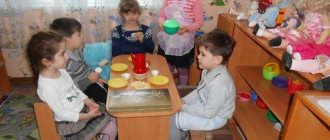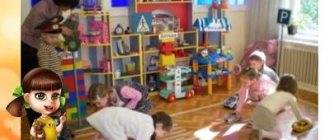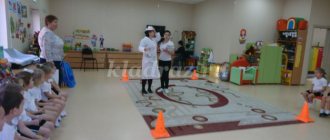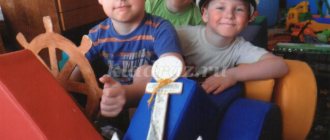Project for the development of role-playing games for preschoolers. Health Center
PROJECT FOR THE DEVELOPMENT OF STORY-ROLE PLAY “HEALTH CENTER”
“A child’s play is not a simple memory of what he has experienced, but a creative processing of experienced impressions, combining them and rebuilding from them a new reality that meets the needs and desires of the child himself.”
L.S. Vygotsky. We believe that one of the interesting, bright and creative games for children should be the game “Health Center”.
It is accessible to preschool children, since from birth the child has a genetically unconscious interest in the medical profession, in himself, in his body parts, organs and their functions. Psychologically, a small child is already ready to play the game, but due to insufficient life experience and knowledge, he cannot develop a sufficiently bright, consistent storyline. The plot-role-playing game “Health Center” is a creative game, free from regulation, a game that allows the child to express his fantastic desires, his dreams. Here the child has a wide scope for creativity, activity and ingenuity, imagination, curiosity, and self-realization. Children of older preschool age can do this. In this game, the child not only reflects real life, but also rebuilds it; this game also has developmental significance. Here, in a complex, it is possible to solve the problems of mental, moral, labor and aesthetic development of children. This game requires the child to have complete knowledge about the world around him, about his body, about the structure of his body, organs, about methods of treating them, about medicinal herbs and medications. During the game, the child clarifies and consolidates knowledge about the profession of a doctor, pharmacist, physiotherapist, the work of an ambulance, and the Ministry of Emergency Situations. In addition, this game teaches children to live successfully and act together, to help each other. Here a sense of collectivism, mutual assistance, responsibility for one’s actions, and communication skills develops. The game "Health Center" is aimed at developing love for one's neighbor, sympathy for a sick person, and a kind and affectionate attitude towards them. The problem of children choosing themes for games is very acute. Insufficient equipment with attributes, an incomplete amount of knowledge and imperfect creation of conditions leads to the fact that children's role-playing games become monotonous and meager in theme and development of storylines, limited to games with the family, school, hospital, and kindergarten. These methodological recommendations for the game “Health Center” will help educators and teachers of preschool educational institutions use them in their work, diversify and enrich the content of the game, by introducing the roles of doctors - specialists of a narrow profile: ENT doctor, ophthalmologist, surgeon, dentist, etc. Goals and objectives of the game 1. To introduce children to the concepts of “health” and “medicine”. On this basis, give children the opportunity to realize their needs and interest in this topic through the development of the “health center” game plot. 2. Expand children’s knowledge about human health, the influence of lifestyle on health, and the peculiarities of the functioning of the body. 3. Develop the child’s gaming experience by enriching his impressions of the social world and the work of adults (doctor, nurse, pharmacist, emergency rescue workers, etc.). 4. Activate fantasy, verbal communication and creative imagination in creating new storylines. 5. Foster respect for the work of medical workers, establish rules of behavior in public places. 6. Contribute to the development of cognitive and research activities. Stages of age development of the game “Health Center”
Vocabulary minimum Professions: Chief physician, doctor, nurse, pediatrician, therapist, surgeon, ophthalmologist, otolaryngologist, dentist, cardiologist, allergist, massage therapist, nurse, laboratory assistant, cosmetologist, neurologist, pharmacist, pharmacist. Tools: Medical instruments, syringe, scalpel, phonendoscope, forceps, thermometer, cotton wool, gauze, bandages, spatulas, hammer, adhesive plaster, heating pad, tube quartz, dropper, test tubes, tonometer, scales, stadiometer. Additional professionally significant concepts: Temperature, sore throat, otitis, acute respiratory infection, ARVI, plaster, trauma, wound, emergency room, runny nose, cough, headache, toothache, caries, chills, dizziness, runny nose, fracture, sunstroke, burn, analysis , treatment room, fluorography, x-ray, ECG, ultrasound, filling, operation, certificate, sick leave, prescription, card, referral, hospitalization. Name of work actions: Treats, weighs, operates, bandages, examines, directs, receives, prescribes, receives, observes, listens, diagnoses, measures blood pressure, examines, studies, saves, checks, gives injections, massages, applies plaster. Stages of development and implementation of the role-playing game project “Health Center” 1. Setting the goals of the game, the presence of motivation. 2. Involving children in solving this problem (designating a “children’s” goal). 3. Create a game plan (based on child support). 4. Discuss the plan with the children. 5. Creative search (collection of information, material). 6. Carrying out basic activities, preliminary work - classes, observations, games, etc. 7. Homework for parents. 8. Independent creative work with children. 9. Presentation of the project (KVN, holiday, open lesson, compilation of albums). 10. The result of the work is the role-playing game “Health Center” - an organized, long-term game. Approximate game actions: 1. Arrival at the clinic, registration; 2. Appointment with a doctor; 3. Prescribing medication; 4. Calling an ambulance; 5. Hospitalization, placement in a ward; 6. Prescription of treatment; 7. Surveys; 8. Visiting the sick; 9. Extract. Options and plots of the game “Health Center” (new plot lines) 1. Treatment in a sanatorium. 2. The holiday “Medical Worker’s Day” has arrived. 3. Cosmetology clinic. 4. Scientific and medical laboratory. 5. Ministry of Emergency Situations. 6. Tourism. Roles in the game Doctors - 6 people: Pediatrician Oculist ENT - doctor Surgeon Cardiologist Physiotherapist Nurse at the reception - 1 person Pharmacist - 1 person Nurse in the herbal bar - 1 person Procedural nurse - 1 person Laboratory assistant - 1 person Ambulance attendants - 2 people Ambulance doctor – 1 person Ambulance driver – 1 person Patients – 5 or more people Attributes for the role-playing game “Health Center” Registration 1. Screen “Registration” 2. Robe, nurse’s cap 3. Doctors’ work schedule 4. Directions to doctors - specialists 5. Cards 6. Journal 7. Sick leaves 8. Stamp 9. Telephone.
10. Badges for doctors Surgeon 1. Robe, cap. 2. Surgeon’s journal 3. Forms for prescriptions 4. Operating table 5. Surgeon’s medical table 6. Medical instruments: dropper, syringes, scissors, cotton wool, hammer, bandages, adhesive plaster, scalpel, clamp, tweezers 7. “Izolyator” screen 8. Crib 9. Sheets 10. Blanket Ophthalmologist 1. Robe, cap. 2. Journal of an ophthalmologist 3. Forms for prescriptions 4. Table of letters 5. Table of pictures 6. Set “Optics” 7. Eye of an ophthalmologist. Pharmacy 1. Screen “Pharmacy” 2. Robe, pharmacist’s cap 3. “Medicines” 4. Telephone ENT 1. Robe, cap 2. ENT doctor’s journal 3. Prescription forms 4. Spatulas 5. ENT doctor’s eye 6. Tubes 7. Tube Pediatrician 1. Robe, cap 2. Height meter 3. Scales 4. Changing table 5. Centimeter 6. Pediatrician's journal 7. Prescription forms 8. Spatulas 9. Thermometers 10. Phonendoscope 11. Tonometer Cardiologist 1. Robe, cap 2 Cardiologist's journal 3. Prescription forms 4. ECG medical table 5. Medical instruments 6. Couch 7. Sheet Physiotherapy room 1. Robe, cap 2. Physiotherapist's journal 3. Prescription forms 4. Quartz tube 5. Couch 6. Sheets 7. Exercise equipment Treatment room 1. Robe, treatment nurse's cap 2. Nurse's journal 3. Medical instruments: instruments for blood sampling, test tubes, cotton swabs, syringes, scissors, bandages, adhesive plaster, tweezers, bulb, thermometer, heating pad 4. Soap 5. Towel 6. Sheets Phytobar 1. Bar counter 2. Oxygen cocktail station 3. Cocktail mixer 4. Set of medicinal herbs 5. Kettle 6. Tea service 7. Cups 8. Straws 9. Fruit replicas 10. “Koumiss” replica 11. Dummy cocktails Ambulance 1. Ambulance car 2. Suitcase with medicines for ambulance and the Ministry of Emergency Situations 3. Stretcher 4. Telephone 5. Walkie-talkie 6. Ambulance magazine PRELIMINARY WORK
(Planning educational work) Junior preschool age TASKS : Teach children: - the ability to take on a playing role and designate it for a partner; - the ability to carry out role-specific conditional objective actions; - the ability to enter into an image and stay in it for a certain time; - the ability to change role behavior during the game depending on the roles of the partners; the ability to change your playing role depending on the unfolding plot; - ability to develop role-playing dialogue. To teach to observe basic rules of behavior during the game. Develop speech, enrich children's vocabulary. Support the desire to learn more about the medical profession. Encourage children to take care of their health. Promote the development of games in which children reflect the lives and activities of those around them. CONTENT OF KNOWLEDGE AND REPRESENTATIONS 1 BLOCK Cognitive development and speech development 1. Reading works: “The Cockerel and the Bean Seed” Russian. adv. fairy tale (modeled by O. Kapitsa), K. Chukovsky “Aibolit”. 2. Consideration of illustrations on medical topics: paintings depicting doctors, medical personnel, medical equipment, medicines; pay attention to the work of a doctor - what he does, identify types of activities, professions. 3. Guessing motor riddles like: “What am I doing?” (I bandage, give an injection, listen, etc.) 4. Resolving problem situations based on simple stories: “Tanya caught a cold,” “The doll got sick.” 5. TRIZ - using the component approach of system analysis, consider the system properties of the hospital (supersystem - system - subsystem). 6. Lesson. "Talk about the work of a doctor." Program content: teach children to write a short story about the work of a doctor with the help of an adult; generalize children’s knowledge about the profession of “doctor”. 7. Organizing daily role-playing dialogues (1-2 children) like: “Talking on the phone” - It’s like I’m the chief doctor. I call and find out how doctors work. What attributes do they use? What else do they need to work? and so on. 8. Introducing children to game attributes and showing professional actions with them: (external signs: doctor’s coat, cap, phonendoscope, spatula, thermometer, syringe, bandage, medicine, tonometer, cotton wool, etc.) 9. Teacher’s stories about that how she played “hospital” when she was very little. “I put on my mother’s white coat and glasses, placed a table and two chairs nearby, for the doctor and the patient. I also had a suitcase with tools (a syringe, a phonendoscope, a bandage, cotton wool, a hammer, a thermometer, a spatula). I really loved treating my dolls and parents. 10. Cognitive experiences: - observation of the work of a doctor and a nurse in a medical clinic. office. II BLOCK Artistic and productive activity Drawing and appliqué: “Vitamins” Program content: introduce children to the properties and importance of vitamins in people’s lives, continue to teach how to draw round objects and paint over them. BLOCK III Labor activity Crafting attributes for playing at home together with parents. BLOCK IV Game activity 1. Didactic game “Lya’s teeth hurt” to practice clear pronunciation of onomatopoeic words, the sound [O]. 2. Didactic game “Find the object according to the description.” Objective: To develop the ability to find an object by its most characteristic features; develop observation and resourcefulness; learn to describe an object without naming it. (A.K. Bondarenko, “Didactic games in kindergarten”). 4. Didactic game “Who needs what for work?” Didactic task: to consolidate children’s knowledge that different things and tools help people in their work; to cultivate an interest in the work of adults and a desire to work themselves. 5. Thematic-didactic game “Hospital” - an in-depth introduction to the work of a doctor; development of skills to operate with objects. V BLOCK Entertainment Puppet theater K. Chukovsky “Aibolit” (dramatization of an excerpt) - showing a method of acting with toys and playing materials. STORY - ROLE-PLAYING GAME “HOSPITAL” Role-playing attributes: 1. Doctor doll 2. Set of medical instruments 3. Medicine dummies 4. White coat and doctor’s cap 5. Patient dolls Roles in the game: 1. Doctor 2. 1st family mother and daughter 3. 2nd family father and son Options, plots of the game The doctor is conducting an appointment.
A mother and daughter enter the hospital. My daughter moans: “Oh-oh-oh.” Doctor: Hello. What happened to you? Mom: My daughter is sick. Doctor: What hurts her? Mom: She has a headache. Doctor: Now we will treat the head, and your daughter will stop crying. Open your mouth, please (takes a spatula and looks into your mouth). Oh, she has a sore throat. Let's measure the temperature (puts on a thermometer). And her temperature is high. Here's a tablet (vitamin). Let's listen to the heart, very good! Now you need to give an injection (take a syringe, blot cotton wool with boiled water and give an injection). How are you feeling? Daughter: Thank you, good (laughs). Doctor: So she’s healthy, laughs. A father and his son enter the hospital. The son cries: “Ah-ah.” Doctor: Hello. What happened to you? Dad: My son is sick. Doctor: What hurts him? Dad: He has a toothache. Doctor: Now we will treat the tooth, and your son will stop crying. Open your mouth, please (takes a spatula and looks into your mouth). Oh, yes, he has a toothache. Let's measure the temperature (puts on a thermometer). And his temperature is normal. Here's a tablet (vitamin). Let's listen to the heart, very good! Now you need to give an injection (take a syringe, blot cotton wool with boiled water and give an injection). How are you feeling? Son: Thank you, good (laughs). Doctor: So he’s healthy, laughs. Goodbye. Dad and son: Goodbye. PRELIMINARY WORK
(Planning educational work) Senior preschool age TASKS: • Develop the skills of jointly combining various events. Encourage children to combine creative plot construction with role-playing interaction. • Encourage children to more widely and creatively use knowledge about the surrounding life, the work of doctors, and the functioning of the body in play. Form relationships of cooperation and mutual assistance. Cultivate goodwill, willingness to help out a friend, the ability to take into account their interests and opinions; resolve disputes fairly. • Continue to work on activating and clarifying vocabulary and developing speech. Encourage children to engage in role-playing dialogues, developing coherent speech, and work to develop creative imagination. Block 1. “Cognitive activity” 1. Conversation “What is health and how to maintain it”
Purpose: To consolidate children’s knowledge of how to maintain health, strengthen it, what safety rules to follow so as not to harm health;
develop curiosity, attention to your own body, sensations. 2. Conversation about the work of adults
Purpose: To introduce children to the profession of a doctor.
Reveal its significance for society. Reveal the moral qualities that characterize doctors. Instill respect for the medical profession. 3. Excursions: to the clinic, to the registry, to the pharmacy, to the medical office
Purpose: To expand children’s ideas about medicine.
Arouse interest in this field of activity 4. Watching filmstrips, films about medicine
Goal: Expand children's ideas about medicine.
Arouse interest in this field of activity 5. Reading works:
K.I.
Chukovsky “Aibolit”, an excerpt from the poem “Who to Be” by V. Mayakovsky, “On the Seaside” by J. Rainis (Excerpt “The Doll Got Sick”), “Our Doctor” by A. Kardamova Goal: Continue to introduce children to the profession of a doctor. 6. The teacher’s story about doctors and their activities
Purpose: To expand children’s ideas about doctors and their activities.
Arouse interest in the medical profession. 7. Complex cognitive-physical training session “Health Day”
Goal: To form the habit of a healthy lifestyle;
satisfy children's needs for physical activity; consolidate children's knowledge of how to maintain and improve health. 8. Lesson “What is health and how to preserve and increase it”
Purpose: To consolidate the concept of “Health”;
expand children's knowledge about preventive measures to prevent diseases and injuries. 9. Lesson “Emergency”
Purpose: Talk about the profession of “doctor”;
introduce children to the phone number “03”; teach how to call an ambulance by giving your first and last name and home address. 10. Lesson “How the human body works”
Purpose: To introduce children to how the human body works.
11. Lesson “How the human heart works”
Purpose: To introduce children to the purpose and work of the heart.
12. Lesson “How we breathe”
Purpose: To introduce children to the respiratory system.
13. Lesson “How parts of the body move”
Purpose: To familiarize children with the purpose of muscles, joints, their role in the structure of the human body.
14. Lesson “Microbes and Viruses”
Purpose: To tell children about infectious diseases and their causative agents.
15. Lesson “Personal Hygiene”
Purpose: To bring to the consciousness of children the need and importance of observing hygiene procedures.
16. Lesson “Health and illness”
Purpose: To teach children to be careful about their health, take care of it, and avoid situations that are harmful to health.
17. Lesson “Attitude towards a sick person”
Purpose: To cultivate a sense of compassion, sympathy for the sick and infirm;
to awaken a desire to help, to alleviate the plight of such people. 18. Lesson “Vitamins and healthy products”
Purpose: To introduce the concept of “vitamins”, talk about the benefits of vitamins, their importance for life, the relationship between health and nutrition.
19. Lesson “Healthy food”
Purpose: To help children understand that health depends on proper nutrition, to explain that food should not only be tasty, but also healthy.
20. Lesson “Sports”
Purpose: To introduce children to various sports, to form the concept of a healthy lifestyle, and the importance of sports for human health. Block 2. Labor activity
Block 3. Play activities
Block 4. Artistic and productive activities
Block 5. Entertainment and holidays
We recommend watching:
Plot-role-playing game in the senior group of kindergarten Summary of the plot-role-playing game “Cafe” for the senior group of kindergarten Project. Development of role-playing games in the middle group of kindergarten Story-role-playing games in the senior group "Theater"
Similar articles:
Educational game in the preparatory group of kindergarten





